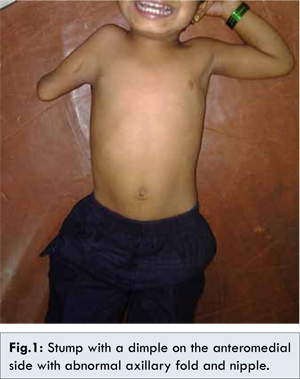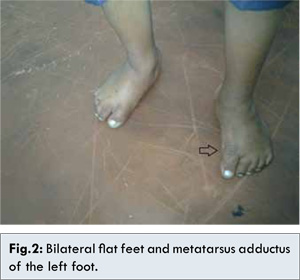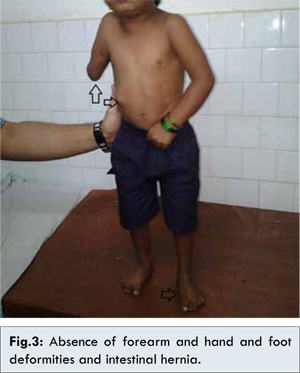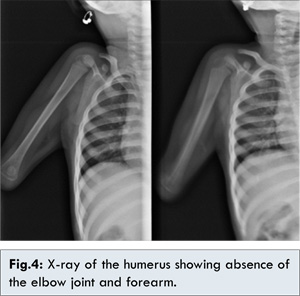Introduction
There is little information on the incidence of congenital limb deficiency in the population, and what is reported varies widely. Most limb deficiencies seen in childhood are congenital in origin [
1]. The incidence of congenital anomalies is 1% to 2%, and approximately 10% of these are upper-extremity abnormalities [
2]. These anomalies require an accurate diagnosis and communication of relevant information to the family. The anomalies of the upper limb are classified on the basis of embryology, teratologic sequencing, and/or anatomy. The anomalies can occur in combination with various syndromes, with other musculoskeletal problems or occur in isolation [
2].
Although upper-extremity amputations of all types are unusual, in children congenital amputations are far more common than acquired amputations. In addition, one congenital upper-extremity deficiency, below-elbow transverse deficiency, is more common than all others, combined [
1]. The aim of this case report was to present an unusual congenital deficiency of upper limb and discuss the various treatment modalities of such conditions.
Case Report
A 4 year old patient presented with the congenital absence of right distal humerus, elbow, forearm and hand. The child was full term normal delivery born out of a non-consanguineous marriage and had two other siblings one male and one female child. None of the siblings showed signs of any deformities. There was no history of trauma, drug intake, delayed developmental milestones in child or any history suggestive of teratogenic exposure to mother.
On examination, the child was noted to have a nubbin at the arm level 18 cm from the acromion with the absence of the distal part of humerus, elbow joint, the forearm and the hand [Fig.1]. The lower limbs showed bilateral flat foot with associated left sided metatarsus adductus [Fig.2]. A small nevus about 0.5 cm was noted on the thoracic spine with tuft of hair present on it. There was weakness of the abdominal wall on the right side with intestinal hernia on bending forward.


The skin of stump was normal in appearance with no local rise of temperature. The humerus was palpated above the stump and the stump was soft with preserved sensations. The movements at the right shoulder were normal. Left upper limb was normal while flat foot deformity was noted in lower limbs [Fig.3].

X- Ray of the right upper limb [Fig.4] showed the absence of the distal humerus epiphysis. Further investigations were advised but due to financial constraints and unwillingness of the patient, could not be performed.
 Discussion
Discussion
There is little information on the incidence of congenital limb deficiency in the population, and what is reported varies widely, from 1 per 4264 in Canada to 5 per 10,000 in Australia to 310 per 10,000 in Tayside, Scotland [
2]. The most common cause in children is congenital followed by trauma and tumors. Fibular deficiency is the most common long-bone deficiency. The incidence is between 7.4 and 20 per million live births [
2].
Embryogenesis of the upper extremity commences with formation of the upper-limb bud on the lateral wall of the embryo four weeks after fertilization. Differentiation begins at the shoulder and proceeds down the limb to the hand in linear progression. Eight weeks after fertilization, embryogenesis is complete and all limb structures are present [
3]. It is during this crucial period of formation that most congenital differences occur.
There are numerous systems for classification of upper-limb anomalies on the basis of embryology, teratologic sequencing, and/or anatomy. Each classification system had its merits and de-merits but as the subject of genetics expanded, they started getting outdated. Embryologic classification defines the defect according to the malformation during limb development. Teratologic sequencing grades congenital anomalies according to the severity of expression [
4]. In the subsequent weeks of pregnancy i.e. from nine through term, or the fetal period, the upper extremities grow and mature, and malformations are much less likely and are mostly due to development of amniotic constriction band.
The failure of formation is either transverse deficiencies or longitudinal deficiencies. Transverse deficiencies include all congenital amputations, with the name of the amputation describing the point at which the remaining limb ends. The most common manifestation is a unilateral below-elbow amputation [
4]. The most widely accepted classification of congenital limb anomalies was proposed by Frantz and O’Rahilly and presented by Swanson [
5,
6]. This system defines the anomalies according to the embryonic failure during development and relies on the clinical diagnosis for categorization.
In our case, based on the history given by the parents, the child was suffering from congenital absence of both the forearm and the hand, which was the major deformity present. Based on the classification systems this is a vertical absence [
7]. Since the parents didn’t agree for a treatment protocol, no prosthesis was prescribed. Venkatrao et al reported a case of congenital absence of humerus in which the forearm was directly attached to the shoulder. In that case since the parents were not interested, no treatment was given [
8]. Roswell Park described a case of congenital absence of radius with a club hand deformity for which operative procedure was done with acceptable results [
9].
With the advancements in microsurgical techniques, various treatment options for the congenital anomalies of the upper limb have been developed. These include transfer of toes for the replacement of finger, distraction transposition, transverse soft tissue distraction, callus distraction and syndactyly separation [
10].
For complete absence, prosthetics have significant leaps to provide functional upper limbs. The development of hooks for hands and recently the use of myoelectric hands have enabled the amputee to lead a near normal life. The problem most orthopaedicians face is when to prescribe the prosthesis. Review of the available literature recommends fitting from the ages of 2 months to 2 years [
11,
12]. Fitting of the prosthesis before 2 years of age has shown to have lesser rejections by the child amputee than children prescribed at a later age [
12]. Body powered prosthesis are generally used. Fitting the prosthesis early helps the child psychologically as well as training with the prosthesis helps the child to be at ease in future. Various modifications to the prosthesis are required as the child keeps growing and this should be kept in mind by the surgeon and the prosthetist. Currently myoelectric prosthesis are being used after the child has learned to control the body powered prosthesis and these prosthesis have increased the range of the amputee than the earlier hook prosthesis. Most of the prosthesis comes with an exchangeable hand depending of the function required at the particular time [
13].
Further studies are required to understand the causes of these congenital conditions and evaluate treatment outcomes for such patients. Advances in prosthetics havelead to near normal life of such patients and with co-operation of parents, patients further advances can be made. With the research in germ cell, who knows one day medical science will help us grow a new arm for such defects.
Conclusion
Congenital anomalies such as absence of the forearm are rarely seen by the orthopaedic surgeon and a general idea of the various management techniques available for proper treatment of such cases is presented.
References
- Morrissy RT, Weinstein SL. “The child with limb deficiencies”. In: Lovell &White’s PediatricOrthopaedics, 6th edition. Lippincott Williams & Wilkins;2006:1300-1384.
- Flatt AE. Classification and incidence. In: The care of congenital hand anomalies.2nd ed. St. Louis, MO: Quality Medical Publishing; 1994. pp. 47-63.
- Bamshad M, Watkins WS, Dixon ME, Le T, Roeder AD, Kramer BE, et al. Reconstructing the history of human limb development: lessons from birth defects. Pediatr Res. 1999;45:291-299.
- Heest AV. Congenital upper extremity differences: Understanding the etiology and treatment. A Pediatric Perspective 2001;10:1-4.
- Frantz CH, O’Rahilly R. Congenital skeletal limb deficiencies. J Bone Joint Surg Am.1961;43:1202-1224.
- Swanson AB. A classification for congenital limb malformations. J Hand Surg [Am].1976;1:8-22.
- Martin AE. Reconstruction of congenital anomalies of upper extremity. J Bone Joint Surg. 1959;41:681-701.
- Vyaghreswarudu C, Venkatrao B, Rangachari P. Congenital absence of humerus. Indian Journal of Pediatrics 1961;28:242-246.
- Roswell P. Congenital defect of forearm, absence of radius, club-hand, etc. Plastic operation. J Bone Joint Surg Am.1901; 01:144-146.
- Parker C. A case of congenital deformities of the arms and legs. J Bone Joint Surg. Am. 1901;s2-16:302-327.
- Fisher A. Initial Prosthetic Fitting of the Congenital Below-Elbow Amputee: Are We Fitting Early Enough? Inter-Clinic Info Bull. 1976;15:7-10.
- Scotland TD, Galway HR. Long Term Review of Children with Congenital and Acquired Upper Limb Deficiency. J Bone Joint Surg (Br) 1983;65:346-349.
- Shaperman J, Landsberger S, Setoguchi Y. Early Upper Limb Prosthesis Fitting: When and What Do We Fit. JPO. 2003;15:11-17.